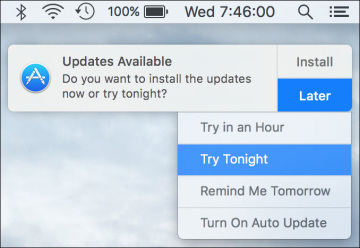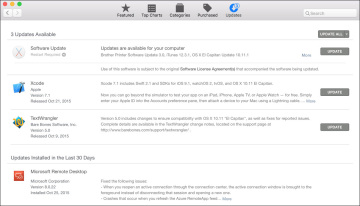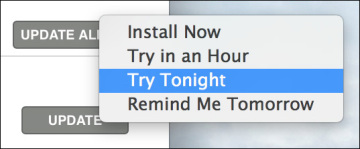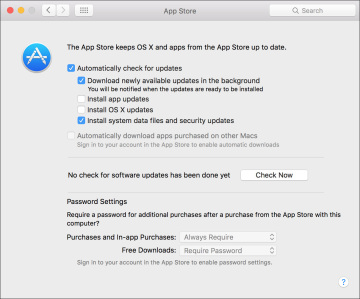How to Update OS X Software
Adding new capabilities is the very reason “software” exists. It’s expected that you will add new applications to increase the capabilities of your Mac and, as products are refined, add new software updates as well. In this lesson, you will configure and use the OS X software update technology, which is an automatic method to keep all your Apple-sourced software up to date. You will also explore an alternative to automatic software updates: manually downloading and installing software update packages.
Reference 4.1 Understand Automatic Software Update
Keeping current with software updates is an important part of maintaining a healthy computer. For that reason, OS X includes an easy-to-use software update mechanism that automatically checks the Apple servers via the Internet to make sure you’re running the latest Apple-sourced software. Automatic software update checking is enabled by default as soon as you start using your Mac.
Both automatic and manual software updates require an Internet connection to download update installers. The automatic software update mechanism checks only for updates of currently installed Apple-sourced software, including software included with OS X and any software purchased from the Mac App Store.
For most users, Mac App Store software updates require appropriate Apple ID authentication. If you have not previously signed in to the Mac App Store from the computer you’re working on, you will be required to authenticate with an Apple ID. If a Mac App Store item was installed with a different Apple ID and you wish to update the item, you must authenticate with the Apple ID used to purchase the original item.
Automatic Software Update Behavior
OS X features unified software updates via integration with the Mac App Store, meaning that all software you have installed from the Mac App Store, including OS X itself and applications created by either Apple or third parties, is updated from a single location. Further, software update is integrated with the Notification Center to let you know as soon as new updates are available for installation.
Assuming the default settings, updates for important system files and security software are always automatically downloaded and installed. On the other hand, by default, most OS X system and Mac App Store updates are automatically downloaded in the background but not installed. In this case, when updates are ready to be installed, a Mac App Store notification displays, stating “Updates Available.”
From this notification you can click Install or Restart, which will immediately install the updates and restart the computer if necessary.
Alternatively, from the Mac App Store notification you can click Later to display a pop-up menu enabling you to defer the update until a more convenient time. This is especially useful because some system updates prevent you from using the computer while the installation completes, in addition to requiring a restart. The last item in this menu, Turn On Auto Update, allows you to turn on automatic updates for Mac App Store items. This option is not turned on by default on new OS X systems.
Again, by default on OS X, Mac App Store updates will not automatically install. You may, however, receive an additional notification that asks “Turn on Auto Updates?”
Clicking the Turn On button from this notification turns on automatic installation for Mac App Store items. As stated previously, by default, important system and security software are always updated.
After deferring updates, when you are ready to install updates or want to manually check for new updates, you can do so at any time using the following methods:
- In the About This Mac window, click the Software Update button.
- In the Mac App Store preferences, found in the System Preferences application, click the Check Now button.
- In the toolbar of the Mac App Store, click the Updates button.
Mac App Store Update Details
When the Mac App Store opens to show you new updates, each update is listed with information about the software update contents. The information provided includes the update name, the Mac version, and a description. Updates that require a system restart include a notice below the update’s name.
As in the previous screenshot, the Updates list is split into three sections:
- At the very top are OS X software updates—This section contains only updates for OS X itself or updates for Apple software installed outside of the Mac App Store. Thus, updating these system items does not require that the user be signed in to the Mac App Store. (This is similar to the software update mechanism available in earlier versions of OS X.) To simplify the view, multiple software updates in this top section are hidden. You can see all the updates and their descriptions by clicking the More link next to the Update button in the top section.
- In the middle are individual Mac App Store updates—Items purchased from the Mac App Store, aside from OS X itself, always appear as separate update items. In this screenshot, both Xcode and TextWrangler require updates. Again, you can see more information about any individual software update by clicking the More link in the description. If the Install OS X El Capitan application is still on the system, you may also notice that an update appears for this application within the Mac App Store updates. This is to update any older OS X installer with the latest version.
- At the very bottom are previously installed updates—This section lists only updates installed by this user from the Mac App Store within the last 30 days. It does not list updates installed outside of the Mac App Store or by other users. A complete list of installations can be viewed using System Information, as covered later in this lesson.
To install a single update, simply click the corresponding Update button, or click the Update All button to install all available updates. If none of the updates requires a restart for installation, the software automatically installs without any further interaction.
However, if any of the updates requires a restart after the install process, you are given the option to restart or again defer the installation. If the update items have already been downloaded, a notification displays.
If any of the update items haven’t been downloaded, a different dialog appears so that you can confirm you want to download the items and then restart.
In either case, when you select a restart option, the system verifies the downloaded updates, logs out the current user, installs the updates, restarts the system, and then automatically logs back in to the user account that initiated the updates. In the case of an update that requires a restart, through much of the update process the computer will be unusable by the user.
You can, of course, choose the Not Now button, but you will eventually have to restart to take advantage of the new software. Alternatively, if updates requiring a restart are already downloaded, you can choose an automatic installation option from the Later pop-up menu in the restart notification (shown previously) or from the pop-up menu to the right of the Update All button in the Mac App Store. As you can see in the following screenshot of the Later pop-up menu in the Mac App Store, you can choose to automatically defer the software installation and system restart to a time when it’s more convenient.
Bundled Mac App Store Apps
New Mac systems come with iMovie, GarageBand, Pages, Numbers, and Keynote installed along with OS X. These apps will probably also need to be updated. Updating these apps requires that the user’s Apple ID owns licenses of the apps. To facilitate this on new Mac systems, a user may “adopt” or “accept” the free app licenses that came bundled with the Mac in the Mac App Store with his or her Apple ID. For more information about accepting these applications, see Apple Support article HT203658, “Accept bundled apps using the Mac App Store.”
Older Mac systems upgraded to OS X El Capitan that also have a previous version of iMovie, Garage Band, and the iWork suite of applications can upgrade, for free, to the latest Mac App Store versions. The software update process automatically detects these updates, but you have to authenticate with an Apple ID to accept the licenses for the new versions. For more information about updating these applications, see Apple Support article HT201064, “Update iMovie, Pages, Numbers, Keynote, and Apple Remote Desktop apps that came with your Mac.”
Automatic Software Update Preferences
App Store preferences, accessed via the System Preferences application, enable you to control the software update automation. Changes made in App Store preferences apply systemwide, so these settings will affect all users and how they interact with the Mac App Store.
From the App Store preferences, you can select or deselect the following Mac App Store and automatic software update options:
- Automatically check for updates—When this option is selected, the system checks for updates once a day. Note that “check” means that only a small amount of Internet bandwidth is needed to determine whether updates are needed.
- Download newly available updates in the background—In this case, the update system may need to use a large amount of bandwidth to download updates. It’s not uncommon for OS X system updates to weigh in at over 1 GB. Also, because this option will automatically download updates for applications purchased from the Mac App Store, systems with more applications will likely use more bandwidth.
- Install app updates—This option is not selected by default, but, as covered previously, the system prompts you to select this option via a notification. Once it’s selected, you are notified after new Mac App Store items are automatically updated or if you need to quit the application to apply the update. Importantly, automatic Mac App Store updates do not require a system restart.
- Install OS X updates—This option is not selected by default, but, as covered previously, you can also select this option via a notification. Once it is selected, you will be notified after new OS X system items are automatically updated, as long as they don’t require a restart. Again, any OS X updates that require a system restart allow you to restart immediately or wait until later.
- Install system data files and security updates—If Apple deems these updates important enough that they should always be installed, it’s a best practice to leave this option selected. Keep in mind, though, that some system and security updates require that the system be restarted.
- Automatically download apps purchased on other Macs—This feature is off by default. If this feature is turned on, when you are signed in to the Mac App Store with an Apple ID, new installations made from another Mac using the same Apple ID will automatically install on this Mac as well. This is handy for those who use multiple Mac systems.
- Password Settings—These settings likewise apply only if a user is signed into the Mac App Store with an Apple ID. Adjusting these settings will reduce the number of times a user has to authenticate their Apple ID when making multiple purchases and free purchases.
In App Store preferences, you can also click the Check Now/Show Updates button to manually open the Updates section of the Mac App Store.






